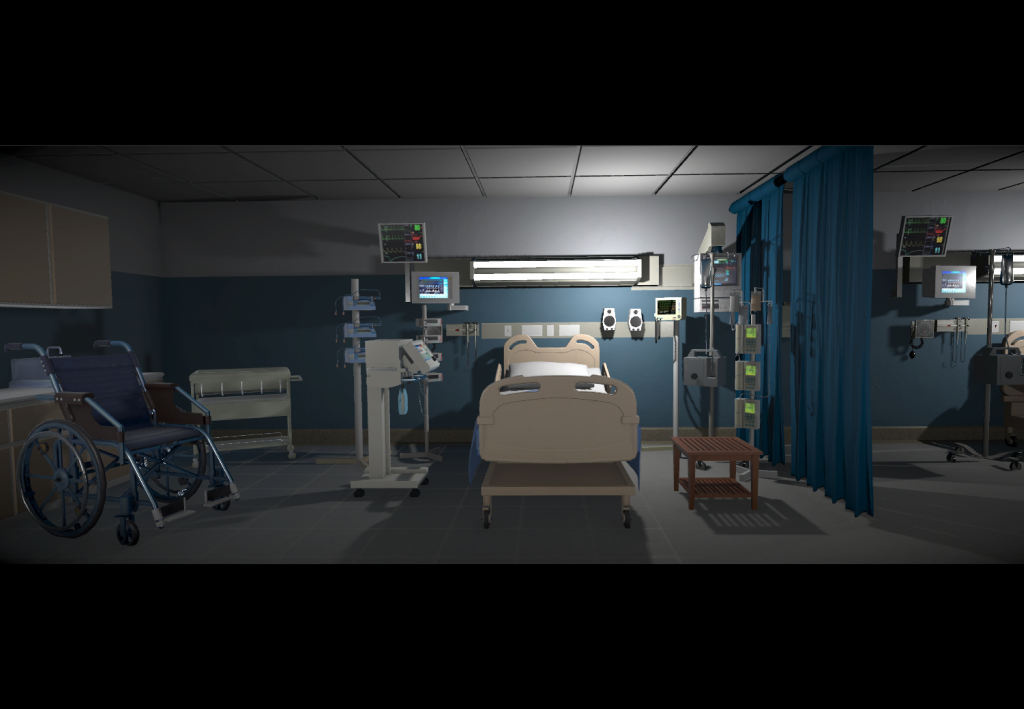2021 Is a Pixel Perfect Performance

Content warning: ‘2021’ contains depictions of war, violence, terminal illness, divisive politics, misogyny, and being unhoused. While these topics are not discussed in depth in this review, they are significant topics in the performance. The show also contains strobe lights and other bright flashes.
Imagine this: you walk into a room and see ten objects laid out in front of you. A wallet, a medallion box, two remote controls, a Father’s Day card, a photo book, a radio, a stack of papers, an empty milk jug, and a cell phone. Carefully and strategically placed by Scenic Designer Helen Yung, you know each of these items holds the memories of a person, but you don’t know who exactly. Soon, you will find that the owner of these belongings is Brian Lewis, an unhoused veteran who is the father of Cole Lewis, the co-creator and performer of 2021. Lewis, along with Co-creator and Performer Patrick Blenkarn will guide you through the video game version of the very real story that is the last two weeks of Brian Lewis’s life. Exploring themes of parenthood, the effects of war, ethics in artificial intelligence (AI), and terminal illness, 2021 is a show that can connect with people from all walks of life.
The show is a part of the Festival of Live Digital Arts (FOLDA) and, as mentioned in my most recent review, FOLDA uses ALPHA, BETA, GO programming. 2021 is categorized as a BETA performance, meaning it has completed the earliest stage of development but still requires more public testing to further strengthen the performance. At the end of the show, audience members are encouraged to give verbal feedback to help improve the project’s development.
Though incredibly important, performance feedback is not the only interactive aspect of this show. A single audience member is asked to volunteer and sit at the computer set up in front of the projection screen to relive Brian’s life by playing a video game from his perspective. Meanwhile the rest of the audience, still sitting in their seats, are encouraged to offer advice to the player on what options to choose and where to go. This one-of-a-kind setup allows for many fun interactions and connections between the player and audience. During the performance, the player would hover their cursor over the several options and pick based on audience cheers; everyone is included and has a say in the decisions being made. At moments, even Lewis would interject the narration to make playful jabs at questionable decisions made by the player and audience.
Another entertaining and interactive element of the show is the live music performed by Blenkarn. The choice to use live music is especially smart, as it can be tailored to any individual’s unique game-play choices and allows leeway to adapt to any potential problems. Additionally, this choice heightens comedic aspects of the show. For instance, when the player was picking their settings and decided to wear a costume, Blenkarn would suddenly stop playing the playful 8-bit music, bathing the room in silence, and rise to deliver a hospital gown costume to the player, then return to his piano setup and continue the music. Perfectly timed moments like these would send the room into laughter.
I was pleasantly surprised by the use of real-time FaceTime calls from Lewis to the player who has stepped into the role of her father, during the performance. Much like the live music, the in-time aspect of the FaceTime calls allows the show to be tailored to any individual’s unique game-play choices and gives leeway to adapt to any potential problems. It also brings an extra layer to the performance as Lewis has the freedom to look away from the camera and into the eyes of the player, almost as if she is addressing her father face to face. Additionally, this true story took place during the pandemic, and FaceTime calls were a primary form of communication for her and many others looking to keep in touch with their loved ones, offering a striking sense of realism.
What struck a chord with me was that I not only felt like I knew Brian from his daughter’s perspective, but also from his perspective as we followed his exact journey and made his exact decisions. Simple ideas, such as animating and incorporating the ten objects on the stage floor into the video game so that the audience could see them being used by their original owner, were clever and moving. And the genius projection designs, created by Lewis and Blenkarn, made scenes more gut-wrenching. One particular moment that stood out to me was during the shooter game segment of the performance, which portrays Brian’s traumatic memories of war through a first-person perspective. The projection shone on the player, making it appear as though they were actually in the game and being bathed in blood with every failed attempt.
2021 is a truly heartfelt and emotional performance that not only raises awareness about the topics discussed, but also makes them personal to you. Through its truly innovative combination of real life and video game, 2021 tells a tale about embracing spirit and finding a mechanism to hold on. Attending will certainly guarantee a night of laugh-out-loud moments, more than a few tears, and a new perspective on the rapidly evolving reality of digital resurrection.
‘2021’ was a part of FOLDA and played at Theological Hall . For more information, click here.
